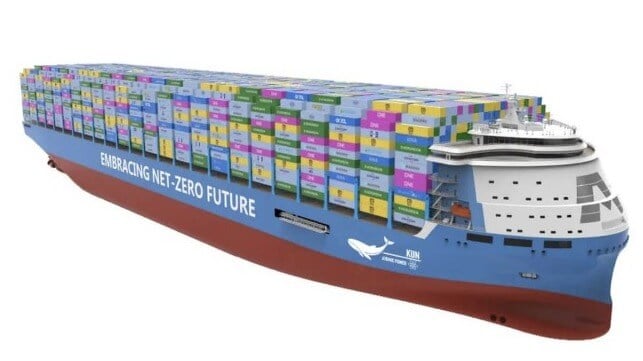CSSC Designs Containership Using Molten Salt Nuclear Reactor

Designs were unveiled in China today, December 5, for the world’s first large containership using the new nuclear power concept known as Molten Salt reactors. The design was developed by Jiangnan Shipbuilding, a division of the Chinese state-owned China State Shipbuilding Corporation (CSSC) and as if to prove that it is more than a theory, they reported that DNV issued an Approval in Principle (AiP) certificate for the design.
Few details were provided for the design with reports highlighting that China has classified the details of its efforts with thorium-based reactors because of the potential military applications. China however highlights that it has an abundant and less expensive supply of thorium meaning that it could be a cost-effective and zero-emission alternative for shipping and other industries. The thorium would be used as a safer alternative to uranium-based reactors.
CSSC writes in a statement posted to Weibo, “This type of ship has high safety as the reactor operates at high temperatures and low pressure, meaning it can avoid in principle core melting.” They highlight that the thorium reactor would not require high-pressure containers and pipelines as the reactor does not use large amounts of water for cooling. In the event of an accident, the core solidifies at ambient temperature, and in addition to normal shutdown methods, CSSC writes that the salt fuel can also be quickly discharged from the reactor to prevent spreading.
The concept design is for a 24,000 TEU containership, which they are calling the world’s largest nuclear-powered containership. Other safety features they reported include the location of the reactor, which was not explained. CSSC highlights that the concept adopts a “double-sided redundant design.”
Reporting on the presentation at a conference in China, the South China Morning Post says China got the first thorium-based molten salt reactor running earlier this year during a test in the Gobi Desert. The paper contends most countries including the United States have abandoned efforts to develop the reactors because of the complexity of the technology.
Several projects are looking at the concept of the Molten Salt reactor to provide mobile power but this appears to be the most advanced design. In the United States, the American Bureau of Shipping was contracted to lead a study into nuclear propulsion and its applications to commercial shipping nearly 80 years after the U.S. demonstrated the first commercial nuclear propulsion ship, the now long-ago retired ns Savannah. Russia continues to operate a nuclear-powered commercial ship while several projects are exploring Molten Salt reactors placed on barges or ships that could be positioned to provide power in remote areas or for emergency recovery operations.
